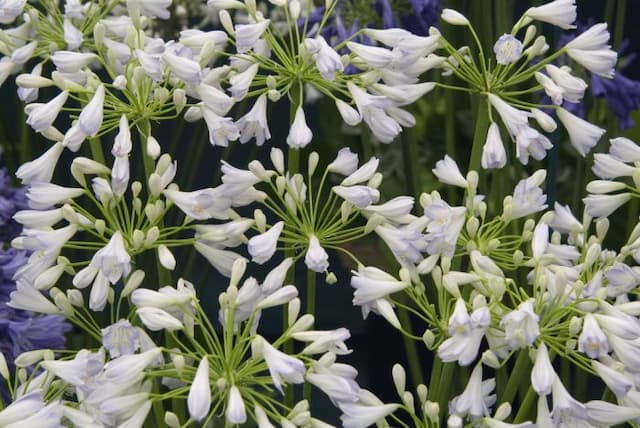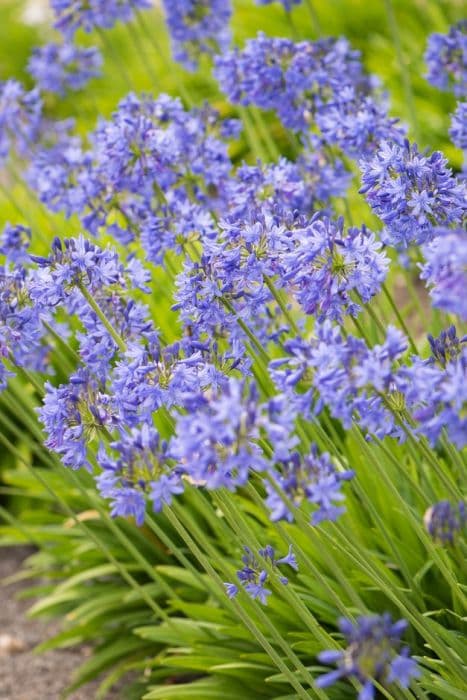Lily of the Nile Agapanthus 'Enigma'

ABOUT
The Agapanthus 'Enigma', commonly known as the African Lily, is a visually striking plant recognized for its unique and elegant blossoms. The flowers of this cultivar are particularly noteworthy, with each individual bloom exhibiting a delicate balance of color. The buds are typically a soft, creamy white with subtle hints of blue at the base, creating a gradient effect that's both eye-catching and serene. As the flowers open, they reveal a trumpet-like form that is a staple of the Agapanthus family, inviting attention with their flared shape and gentle hues that might vary from plant to plant. The African Lily 'Enigma' features flowers that are clustered atop long, sturdy stems, creating a globe-like inflorescence that seems to float above the narrow, strap-like leaves. The foliage itself provides a lush, green backdrop that contrasts beautifully with the graceful blossoms. The leaves form dense clumps that accentuate the flowers, further enhancing the plant's overall elegance. The perennial nature of the African Lily 'Enigma' ensures that it can grace gardens with its presence year after year, bringing with it an aura of mystery and sophistication.
About this plant
 Names
NamesFamily
Amaryllidaceae
Synonyms
African Lily, Lily of the Nile, Love Flower
Common names
Agapanthus 'Enigma'.
 Toxicity
ToxicityTo humans
The Lily of the Nile, as the Agapanthus 'Enigma' is commonly known, is considered mildly toxic to humans if ingested. The symptoms of poisoning can include nausea, vomiting, and diarrhea due to the presence of saponins and possibly other irritating compounds. Skin contact with the sap of the plant can also cause minor irritations or allergic reactions in sensitive individuals. It is advisable to exercise caution around this plant and keep it out of reach of children who might be tempted to ingest it.
To pets
The Lily of the Nile, or Agapanthus 'Enigma', is also toxic to pets, including cats and dogs. If a pet ingests any part of this plant, they may show signs of nausea, vomiting, diarrhea, or excessive salivation. More severe cases of poisoning can result in abdominal pain or lethargy. If you suspect your pet has ingested this plant, it is important to contact a veterinarian promptly. It is always best to prevent access to this plant to keep your pets safe.
 Characteristics
CharacteristicsLife cycle
Perennials
Foliage type
Evergreen
Color of leaves
Green
Flower color
White
Height
2-3 feet (0.6-0.9 meters)
Spread
2 feet (0.6 meters)
Plant type
Bulb
Hardiness zones
8
Native area
South Africa
Benefits
 General Benefits
General Benefits- Aesthetic Appeal: Adds a unique beauty to gardens with its striking flowers and foliage.
- Low Maintenance: Requires minimal care once established, making it an ideal choice for busy gardeners.
- Drought Tolerance: Once established, it can survive with infrequent watering, suited for water-conserving landscapes.
- Attracts Wildlife: The flowers can attract pollinators such as bees, butterflies, and hummingbirds to the garden.
- Long Blooming Period: Provides colorful blooms throughout summer, offering visual interest for an extended period.
- Structural Plant: Can be used to add structure and form to garden beds and borders.
- Adaptability: Versatile in landscaping, suitable for containers, borders, and as accent plants.
- Erosion Control: Its root system can help stabilize the soil, preventing erosion on slopes.
- Seasonal Interest: Foliage remains evergreen in milder climates, giving year-round interest in the garden.
 Medical Properties
Medical PropertiesThis plant is not used for medical purposes.
 Air-purifying Qualities
Air-purifying QualitiesThis plant is not specifically known for air purifying qualities.
 Other Uses
Other Uses- Photography Prop: The striking blooms of Agapanthus can serve as a vibrant subject or background in macro and garden photography, enhancing the overall visual appeal with their color and structure.
- Fabric Dye: The deep blue-violet flowers of the Lily of the Nile have been used traditionally to create natural dyes for fabric, imparting a soft blue hue.
- Culinary Garnish: Although not widely used in cuisine, the blossoms can be utilized as an edible garnish to add a splash of color to salads and desserts, after ensuring they are free from pesticides.
- Floral Art: Live or dried, Lily of the Nile flowers can be incorporated into floral art pieces, such as ikebana or botanical collage, showcasing their sculptural beauty.
- Watercolor Inspiration: Artists may use the delicate gradations of color found in the plant's flowers as inspiration for watercolor paintings.
- Ephemeral Jewelry: The sturdy stems and pronounced flowers of the plant can be crafted into temporary jewelry pieces, such as crowns and bracelets for special events.
- Educational Resource: The plant can be used in botanical studies and gardening workshops to educate enthusiasts on bulbous perennial care and propagation.
- Border Plants: Agapanthus 'Enigma', with its clumping habit, can be planted as a long-lasting border or edging for garden paths, providing structure and aesthetic delineation.
- Creative Crafting: Dried seed heads can be incorporated into creative craft projects like homemade wreaths or as intriguing elements in mixed media art.
- Biodiversity Enhancement: Planting Lily of the Nile in a garden can contribute to local biodiversity by attracting pollinators such as bees, butterflies, and birds.
Interesting Facts
 Feng Shui
Feng ShuiThe African Lily is not used in Feng Shui practice.
 Zodiac Sign Compitability
Zodiac Sign CompitabilityThe African Lily is not used in astrology practice.
 Plant Symbolism
Plant Symbolism- Love Letters: The name Agapanthus comes from the Greek words 'agape' (love) and 'anthos' (flower), symbolizing love letters or messages.
- Secret Love: With its subtle and hidden beauty, Agapanthus can represent a love that is not openly declared.
- Enduring Love: The hardiness and perennial nature of the Agapanthus signify a long-lasting or enduring love.
- Beauty: Agapanthus blooms are striking and attractive, making them a symbol of beauty and admiration.
- Fertility: In some cultures, the abundant flowering of Agapanthus is associated with fertility and creation.
- Rare and Unique: 'Enigma' suggests something mysterious or puzzling, hinting at the unique and rare beauty of the plant.
 Water
WaterFor the African Lily, proper watering is essential for its health and blooming. Water the plant deeply, ensuring the water penetrates the soil to reach the roots, but avoid waterlogging. During the growing season, typically from spring through summer, water once a week with about one to two gallons per plant, depending on the weather conditions and soil drainage. Reduce watering frequency in the fall and further in winter to every two to three weeks, or when the soil feels dry to the touch a couple of inches down. Always adjust the amount of water based on rainfall and temperature, aiming to keep the soil moist but not soggy.
 Light
LightAfrican Lilies thrive in bright, indirect sunlight. The ideal spot is where they can receive full sun to partial shade, with exposure to direct sunlight for at least six hours a day. Avoid placing them in deep shade as this can hinder their growth and reduce flowering.
 Temperature
TemperatureAfrican Lilies prefer a temperate climate and do well in temperatures ranging from 50°F to 80°F. They can survive minimum temperatures down to about 20°F but should be protected or moved indoors to avoid freezing. The ideal temperature range to promote growth and blooming is between 60°F and 70°F.
 Pruning
PruningPrune African Lilies to remove spent flower stalks and encourage reblooming. Pruning can be done after the flowering period, typically in late summer or early fall. Cut the flower stalks back to the base to maintain a tidy appearance and help direct the plant's energy into root and leaf development. Division of clumps may be necessary every few years to rejuvenate growth.
 Cleaning
CleaningAs needed
 Soil
SoilFor an Agapanthus 'Enigma', commonly known as Lily of the Nile, the best soil mix is well-draining, loamy, and rich in organic matter. This plant thrives in a soil pH range of 6.0 to 8.0. A mix incorporating two parts loam, one part peat and one part perlite or coarse sand can work well, ensuring adequate drainage and fertility.
 Repotting
RepottingLily of the Nile should be repotted every two to three years to refresh the soil and allow for root expansion. The best period to repot is in the spring before they enter their growing season. However, these plants prefer to be a bit root-bound, so only upsize if necessary.
 Humidity & Misting
Humidity & MistingLily of the Nile prefers moderate humidity levels but is quite adaptable and can tolerate the drier air found in most home environments. Providing humidity around 40-60% is ideal, but they can withstand variations without significant adverse effects.
 Suitable locations
Suitable locationsIndoor
Ensure bright light, well-draining soil, and occasional watering.
Outdoor
Full sun to part shade, well-drained soil, protect from severe frost.
Hardiness zone
8-10 USDA
 Life cycle
Life cycleAgapanthus 'Enigma', commonly known as Lily of the Nile, starts its life cycle when the seeds are sown in early spring and germinate, developing into small seedlings. These seedlings grow into juvenile plants with strap-shaped leaves, establishing a strong root system. As the plant matures, it enters the vegetative stage, where it focuses on leaf growth. Upon reaching maturity, typically in the second or third year, Lily of the Nile produces tall flower stalks crowned with globular clusters of blue or white flowers in summer. After flowering, seed pods may form and eventually dry, releasing seeds that can be collected for propagation or allowed to self-sow. In colder climates, the plant enters a dormant phase in winter, where the foliage dies back, and it survives as a rhizome until the warmth of spring stimulates new growth.
 Propogation
PropogationPropogation time
Spring-Early Summer
Propogation: The optimal time to propagate the Lily of the Nile, which is commonly known as Agapanthus 'Enigma', is in the spring to early summer when the plant is actively growing and has the best chance to recover from the division and establish well. The most popular method of propagation for this plant is division, wherein the gardener carefully lifts the entire clump from the ground using a garden fork, taking care not to damage the roots. The clump is then gently teased apart into smaller sections, each with a portion of the roots and at least one or two shoots. These sections can be immediately replanted in a well-draining soil mix, ensuring that the crowns are just below the soil surface. It's important to water in the new divisions well and keep them moist but not waterlogged until they are established.









